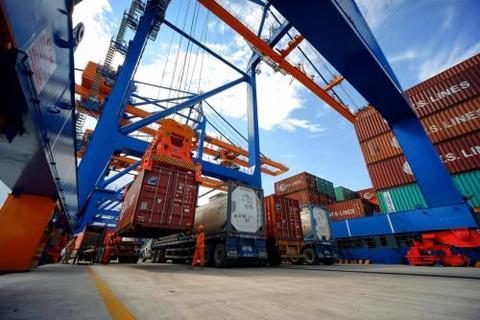 |
The report suggested key risks to the real and external sectors stem mainly from rising trade protectionism. Any impact from the US- China trade conflict on Vietnamese exports would likely be through the global value chain and competition in the domestic and third markets.
However, the US-China trade tension may benefit Vietnam through trade diversion, as well as the potential relocation of foreign firms away from China to Vietnam.
The South China Morning Post (SCMP) cited experts as saying Vietnam, along with other ASEAN’s largest economies such as Thailand and Malaysia, has been laying the groundwork to benefit from the realignment of the global supply chains that the trade war is already contributing to.
According to the report, Vietnam will see opportunities in furniture and apparel, Malaysia in liquefied natural gas, and Thailand in automobiles – with all three benefiting in the information technology equipment and electronics manufacturing sectors.
The combination of predictable regulatory environments, transport infrastructure, and ability to ramp up public spending leaves Vietnam, Thailand and Malaysia poised to receive the wave of investment the trade war is expected to bring, and to weather the region-wide decrease in exports in the process.
As the cost of production rises in China, it is adopting policies to encourage low-skilled manufacturing to move south.
The relocation is also part of the central government’s effort to move the drivers of the nation’s economic growth from production to consumption, experts say – a trend that has been accelerated by trade tensions with the US.
The trade war could knock a full percentage point off China’s economic growth this year, Wang Yang, one of seven members of the Politburo Standing Committee of China’s Communist Party, said on Thursday – the first comments by a top policymaker about the impact of the trade dispute on the government’s growth goals. Beijing had previously forecast 6-6.5% growth for the year.
This had made ASEAN increasingly the driver of global economic growth, Siwage Dharma Negara, senior fellow and coordinator of the APEC study center at ISEAS-Yusof Ishak Institute in Singapore, told SCMP.
Ready to “grab the opportunity”
The factor which limits the extent to which countries can benefit from the trade tensions is infrastructure, said Michael Taylor, chief credit officer for Asia at Moody’s in Singapore, adding that Vietnam, among others, had made major investments to that end.
In January, Prime Minister Nguyen Xuan Phuc said Vietnam was ready to “grab the opportunity” presented by the ongoing spat.
Tommy Wu at Oxford Economics in Hong Kong said beyond the near term, Vietnam will likely be the main beneficiary of a supply chain shift, given its close proximity to China, low wages and favorable trade and foreign direct investment policies.
The nation’s exports rose more than 12% from just a year before during the second half of last year, according to data from HSBC.
Foreign investment into Vietnam this year rose 86.2% to US$10.8 billion in the first quarter. Chinese investment made up nearly half of the total, according to Chinese state-run media.
Last month alone, exports from Vietnam to the US rose 29%, while capital investments from overseas soared more than 200%.
GoerTek – a major Chinese supplier to Apple – and massive Taiwanese tech firm Hon Hai Precision Industry Company, better known as Foxconn, are among prominent firms to have moved their production to Vietnam in recent months.
Clients of Vietnamese furniture company Xuan Hoa, which include global giant Ikea, have also redirected production from China to Vietnam in the wake of the tariffs. The company’s chief executive told Bloomberg last month that at least 10 prospective clients had called from abroad already this year, and he expected sales to double in the next five years.
Vietnam is one of the most open economies in Asia, said Kiran Nandra-Koehrer, specialist in emerging market economies at Pictet Asset Management.
Shifting supply chains from China would be part of an influx in foreign direct investment coming to Vietnam, suggested Nandra-Koehrer, especially in textile manufacturing and even consumer electronics. Hanoitimes
Ngoc Thuy
 Slowing global demand amid rising trade protectionism may pose a substantial challenge to Vietnam’s exports, according to ASEAN+3 Macroeconomic Research Office's (AMRO) ASEAN +3 Regional Economic Outlook 2019.
Slowing global demand amid rising trade protectionism may pose a substantial challenge to Vietnam’s exports, according to ASEAN+3 Macroeconomic Research Office's (AMRO) ASEAN +3 Regional Economic Outlook 2019.